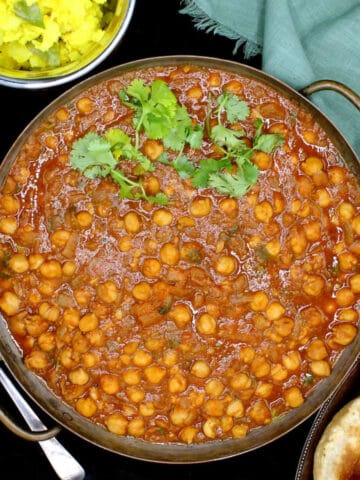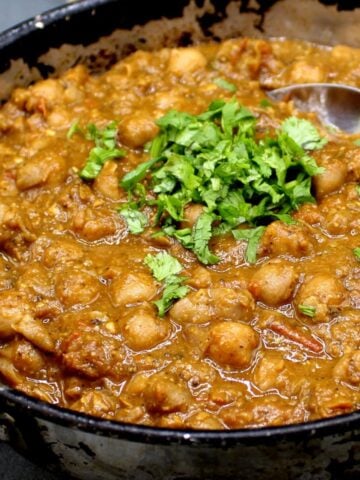What is sarson ka saag?
Sarson (mustard) grows plentifully in the Punjab region, which straddles India and Pakistan, and both the seeds and leaves have a steadfast presence in the cuisine there. One of the most popular dishes made with mustard greens – one that is quintessentially identified with Punjabi cuisine – is sarson ka saag, a creamy green curry made by cooking pureed mustard greens with other leafies, like spinach, and a few simple spices. If you don’t like spicy Indian food, sarson ka saag might just be the dish for you. The mustard greens, with their own peppery flavor, bring a lot of flavor so you can get away without adding too much chili pepper to this dish (although you totally can if you want to!).
A unique, nourishing recipe
Delicious but simple. The sarson ka saag is not a recipe you might find at an Indian restaurant, but it is not unlike other restaurant-style Indian recipes you might already love, like saag aloo or palak paneer. The spicy mustard greens add delicious flavor. Nutritious recipe. It’s a good idea to include a variety of greens in your diet and mustard greens are especially nutritious, loaded as they are with vitamins C and K. They also have good amounts of protein and fiber, all for very few calories. A serving of this dish has only 101 calories total, four grams of protein and four grams of fiber. Low-carb friendly. There are just eight net carbs in each serving of sarson ka saag, making this a must-try for anyone on a low-carb diet. Soy-free, nut-free, gluten-free and vegan. This recipe can be eaten by nearly anyone regardless of dietary restrictions.
Leafy greens for sarson ka saag
Mustard greens, with their pretty, curly leaves, are easily available in the United States (they are much beloved in the American south) and around the world, as is spinach and one more leafy green that is usually added to sarson ka saag: bathua or lamb’s quarters, which enthusiastic foragers will instantly identify as an edible weed. This puts sarson ka saag squarely within the reach of any cook willing to give this uniquely delicious dish a try. The story goes that Punjabi cooks began adding lamb’s quarters to sarson ka saag because the weed grows wild among the mustard greens in the fields. But don’t worry–I won’t send you foraging for lamb’s quarters. Another leafy green, like arugula or watercress, will work just as well, and that’s what I usually use. However, if you do have access to lamb’s quarters, and know how to identify it, you can use it in this recipe.
How to make sarson ka saag
Make the sarson ka saag faster with tomato onion masala sauce
You can make this recipe even quicker if you have a jar of the tomato onion masala sauce. Here’s how to alter the recipe: cook and puree the greens as instructed. Heat oil and add the cornmeal to it. After sauteing the cornmeal for a couple of minutes add 2 cups of the tomato onion masala sauce. Bring to a boil, add the blended greens, simmer 10 minutes, and finish with the garlic tadka. Check to get new recipe updates by email.
Storage instructions
Refrigerate: The sarson ka saag can be stored in an airtight container in the fridge for up to four days. Freeze: Freeze for up to three months in a freezer-safe container. Thaw and reheat: Reheat in a saucepan and add a little bit of water if necessary. Always check salt and add more if needed after adding water.
More delicious Punjabi recipes
Recipe card
I sometimes serve the saag as a side with dal and steamed basmati rice. A vegan raita is wonderful on the side. For a full-blown Indian restaurant experience serve vegan gajar ka halwa for dessert.


















